FLASHBACK FRIDAY! DR. JEKYLL AND MR. HYDE CR500 VS. KX500 SHOOTOUT
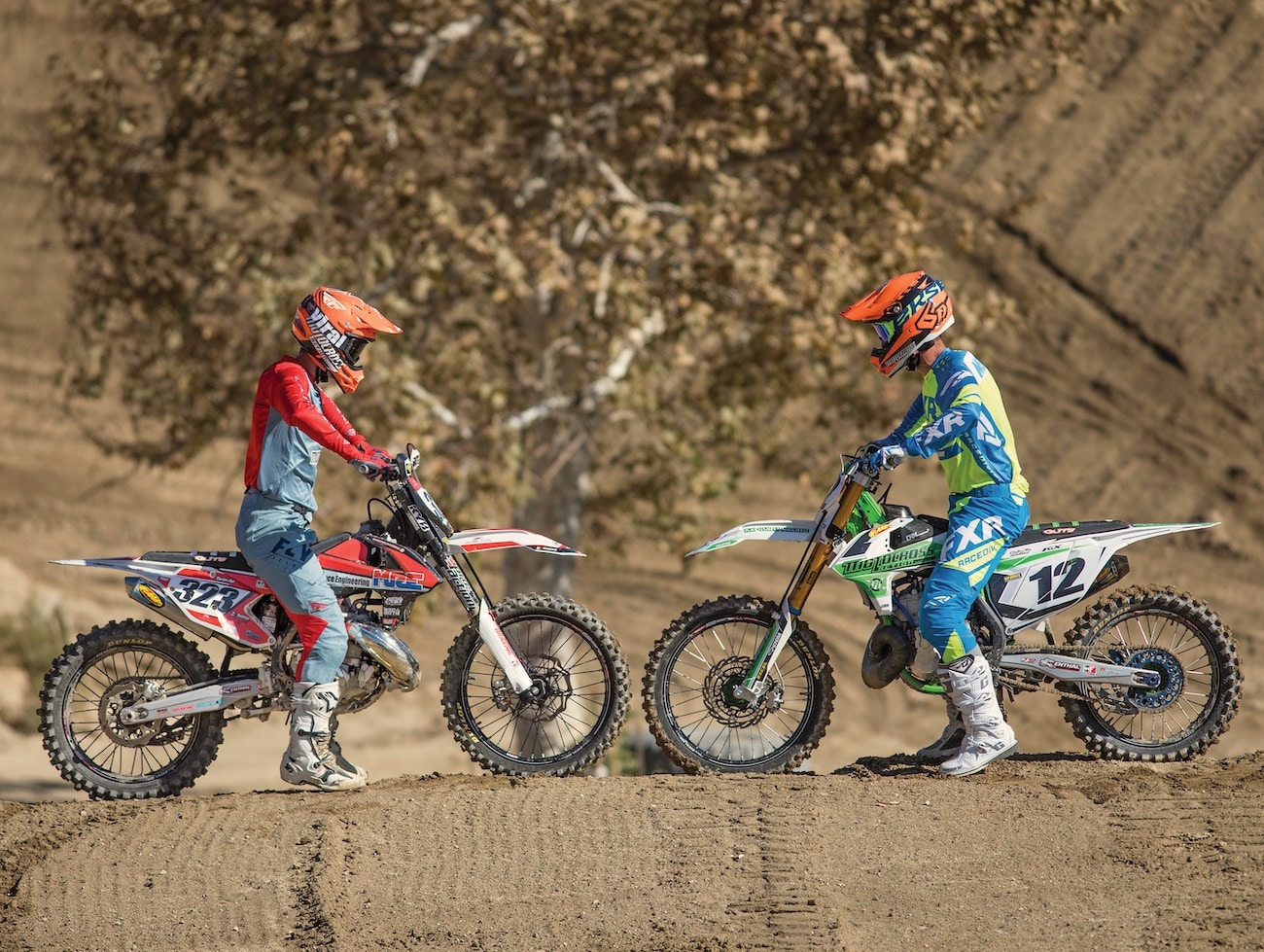
DR. JEKYLL AND MR. HYDE 500cc TWO-STROKE SHOOTOUT: EXOTIC CR500 VS. RADICAL KX500
We are not sure why 500cc two-strokes are making a comeback. Maybe it is because Americans tend to want what they can’t have. There is not one manufacturer on planet Earth that produces a 500cc two-stroke engine that is meant to be shoehorned into a dirt bike chassis. And there is good reason. If you haven’t ridden a 500cc smoker before, don’t start now—unless you need a quick shot of adrenaline to jump-start your heart.
But, we do know two groups of guys who are 500cc two-stroke crazy. Why do they like these big displacement engines so much? Maybe it is because they are stuck in the 1990s. Or, maybe it’s because they have a few screws loose. Whatever the case, MXA is glad they have such a passion for these archaic engines that they insisted on building MXA two exotic 500cc smokers, both in 2016 KTM 250SXF chassis’. The kicker? One is powered by a Honda CR500 engine and the other by a KX500 engine. Adam Millar, who owns Millar Racing Engineering (MRE) in Canada, is a diehard CR500 guy—and you can guess which bike he built. The second group of 500 loonies are KX500 aficionados who call themselves KX Guru Racing. You’d think that they would share a common bond, but instead they have a love/hate relationship. They both think they know which antiquated engine is better than the other, and who can build the best version of a modern 500cc motocross bike. Which is where MXA came into the picture; they asked the MXA wrecking crew to settle the argument. It was a classic 500cc build-off.
MILLAR RACING ENGINEERING VERSUS KX GURU RACING
We are going to get deep into the weeds on these two builds and what it was like to ride them; however, since both chassis’ were constructed on the same basic platforms, we are going to kill two birds with one stone. Choosing to utilize the same 2016 KTM 250SXF rolling chassis was the right choice. This model year’s chromoly steel frame has good flex characteristics in comparison to the stiffer 2019-’20 KTM frames. Having said that, both teams had to cut out the cradle of the frames so the 500cc engine of their choice could be shoehorned in. Amazingly, both Millar Racing Engineering and KX Guru Racing found 2007 KTM 450SXF frames and cut out the lower frame rails on them. This is where the hard part started. The frame rails had to fit perfectly in the donor frame and be welded with precision to ensure all the dimensions were perfect. It was a nerve-wracking and time-consuming task. Once that was done, the engine mount locations were located and measured to ensure the proper engine angle. Since neither engine was made to fit into the KTM chassis, custom engine spacers had to be crafted. Crazy Al’s Racing volunteered to manufacture the custom spacers for both bikes out of titanium. There were a lot more intricate details that went into fitting the powerplants into their new homes, but the guys didn’t want to give up all their trade secrets.
WHAT IS THE KTX500e?
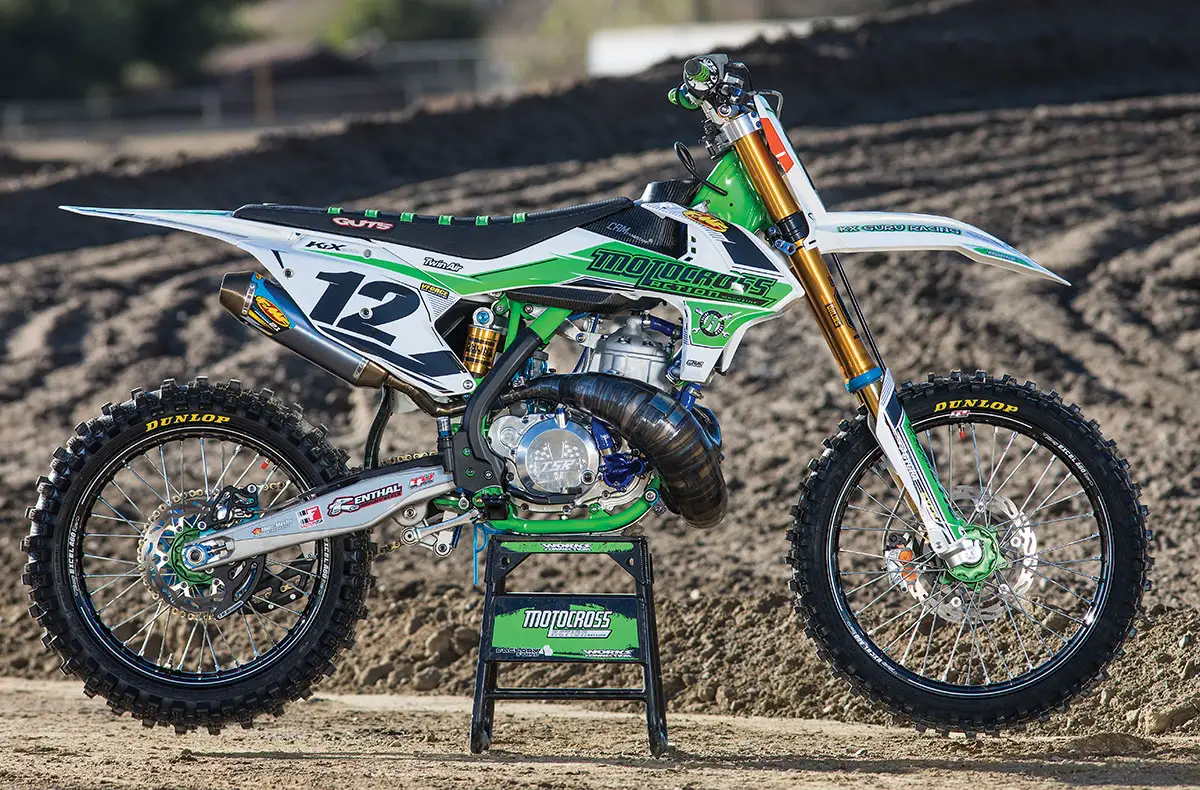
You guessed it, the “e” stands for electric start. This had some serious wow factor, as the Panthera Motorsports KX500 electric-starter kit sounded like one of those high-powered NASCAR tire-changing guns when we pressed the button. Plus, not having to kick start a 500cc powerhouse is really nice. The only downside is that it added weight, which we felt while riding the KTX500e, but we will get to that later.
Everything about this machine was custom. The only two parts that weren’t replaced or heavily modified were the 2016 KTM 250SXF lower clamp and subframe. It took a lot of hard work, time and buckets of money to build this KX500-powered machine. A few years ago we tested Sean Collier’s Kawasaki KX500, which is where we first met the guys from KX Guru Racing. It was a great bike that had a ton of low-to-mid power but fell off on top early, forcing the rider to short shift. KX Guru Racing took that blueprint and tweaked it to make a broader, four-stroke-like powerband. They called it the “Sean Collier Stage 3” engine.

KX Guru Racing started with a set of TSR crankcases (which included a hydraulic clutch) and a two-piece clutch cover from Australia. Then, they added a Boyesen KX250 water pump and impeller. Adam Millar (yes, the same Adam that they were trying to beat), built them a custom head for the KX500 that used the KTM radiator hose fittings and re-chambered it to KX Guru Racing’s specifications. Adam also installed a trick decompression release in the head. Nice guy.
The crank was highly modified and made into what is called a turbo crank. A turbo crank is made by cutting scoops around each side of the crank wheels. This is done to improve the volumetric efficiency of the engine, plus it looks cool (although you’d have to split the cases to appreciate it). The crank was also stuffed by the Rouse family, then sent to Parris Concepts for the induction modifications. After all the crank work was complete, it was mated to a hand-polished Wossner rod that was carefully balanced.
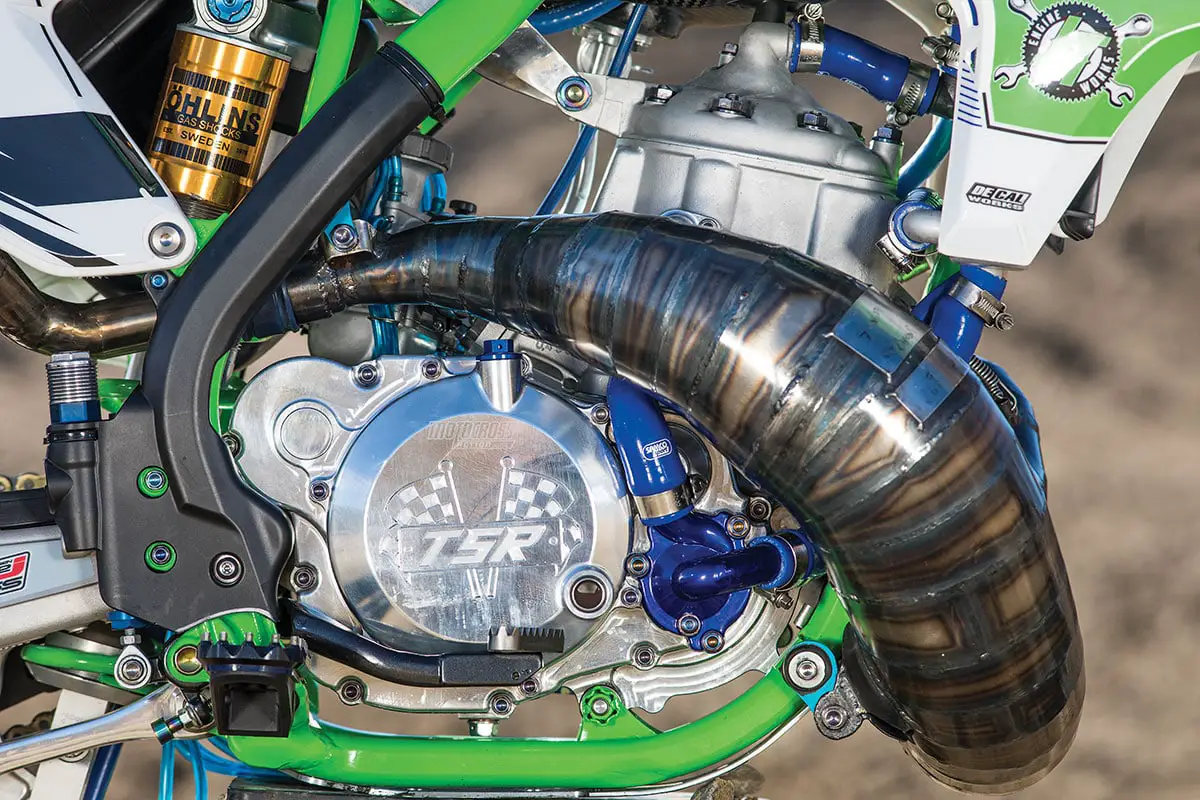
A few old hands at KX Guru Racing had built some of Factory Kawasaki’s KX500 off-road racing engines back in the day for Destry Abbott. Much of the basic cylinder porting mods came from this past knowledge—with a few updates. The cylinder was sent to another past KX500 factory engine builder, Tom Morgan of TMR. Back in the day, Tom was Jeff Ward’s wrench when Wardy raced the AMA 500 Nationals. Tom bored, decked and cut the base to KX Guru’s specs. The most timely part of the build was the power valves. They were completely redesigned and modified to get the shape and flow they were looking for. As for the transmission, all the parts were brand new and hand polished. A bulletproof Hinson basket was used with all its supporting hardware to support the extreme power of the 500cc powerplant. For the carburetor, they went with a Keihin quad-vent Air Striker and a custom MRE reed holder system for the Moto Tassinari V-Force 2 reed cage.

The factory cone pipe was custom built by Growler Racing. It was a lot of work to make the Pit Viper series pipe clear the big starter on the left side of the bike and the water pump on the right; however, the kickstarter boss was plugged so they had one less thing to worry about. The muffler was borrowed from a 2016 FMF KTM 250SX unit. Since the 250SX uses a smaller core than the KX500, it was re-cored by Job Jeffers and built to fit the custom KX500 pipe. Due to the fact that the FMF silencer was titanium, the tubing could not be bent. They had to use the cone pipe method.
In an effort to keep weight down, as they added about 13 pounds compared to their opponent with the electric starter, battery and supporting hardware, just about every bolt used was titanium, save for a few high-stress areas.

Anyone who has raced an Open bike knows that 500cc two-stroke engines can be rattle traps. To reduce vibration, Fasst Company Flexx bars and Impact pegs were used. A Hammerhead KX450 shift lever was used with a 20mm extended tip, as well as their brake lever, although the brake pedal had to be heavily modified to fit around the KX500 engine.
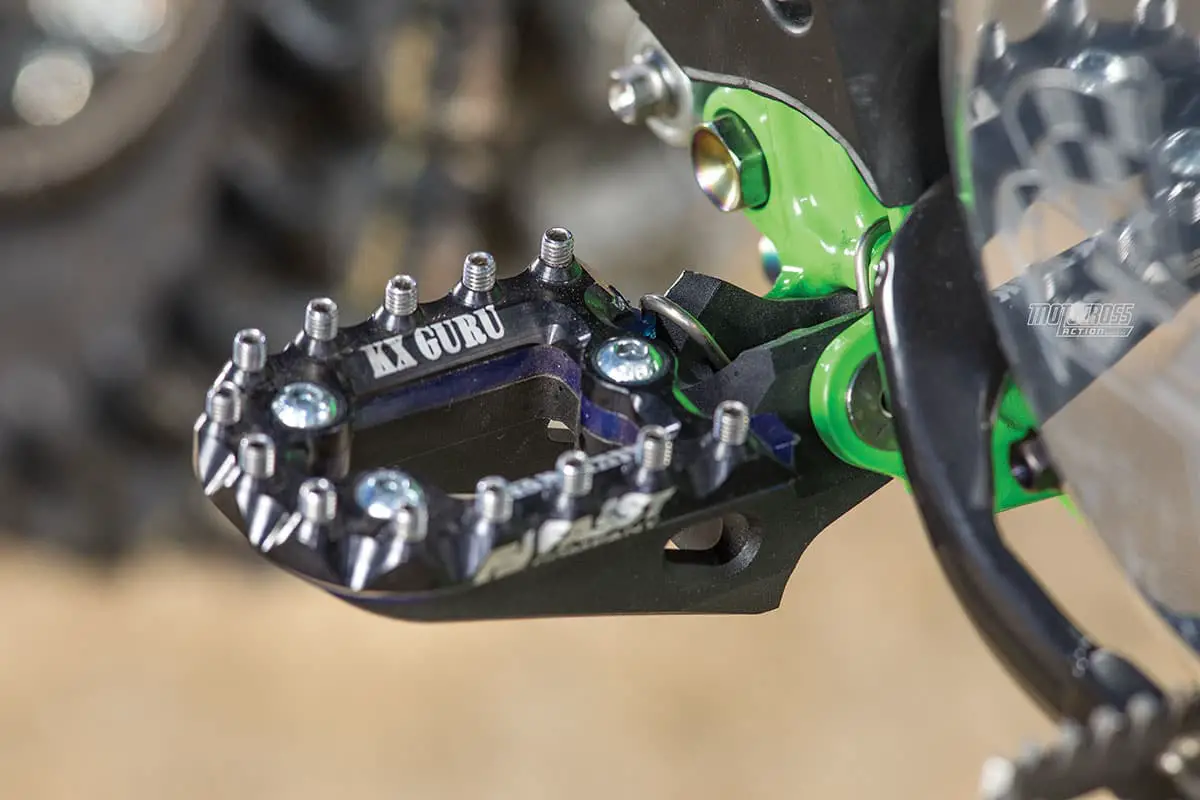
As for the suspension, the original 2016 WP 4CS components were tossed in the trash. Looking out for our own wellbeing, the MXA wrecking crew had tested some dialed-in Ohlins components the year before on a KTM 450SXF. The KX Guru guys asked us how we liked the Ohlins TTX Flow shock and RXF 48 forks and we said we loved them. We got them in touch with Ohlins and they bought the exact components that we tested to use for their build.
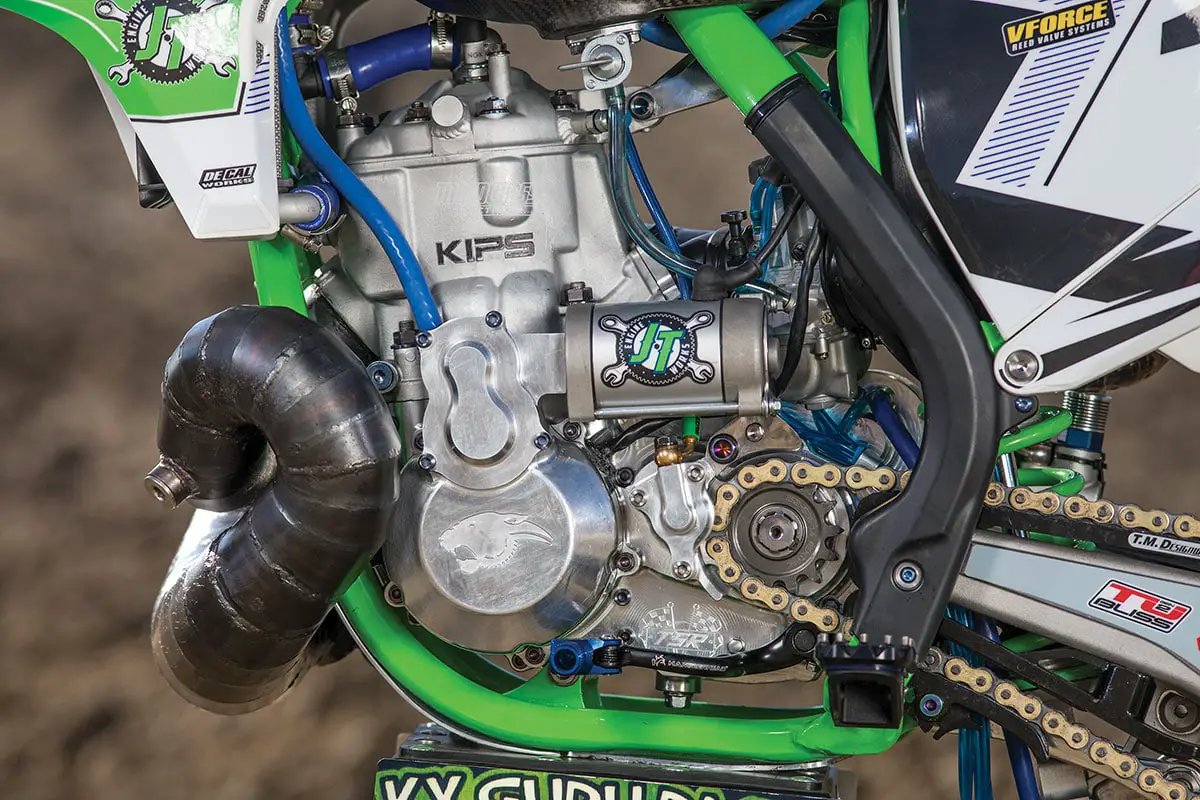
Many great companies came together to pull this exotic KTX500e together. DeCal Works customized the graphics. Works Connection supplied the titanium fasteners, skid plate and more. Renthal supplied the chain and sprockets. TuBliss tubes were used. Faster USA laced up Excel A60 rimes on their custom green hubs with stainless steel spokes. Twin Air provided the air filter. Moto-Master added in the oversized front rotor and braided stainless steel brake lines. Guts Racing built the seat. TM Designworks added the bulletproof chain guides. CRM Karbotank did the tank, and MotoGear Speed shop pitched in a bunch.
WHAT WAS IT LIKE TO RIDE THE BIG KX500?

This beast produced 72 horsepower on the dyno. And yes, we felt every bit of it on the track. The eye-watering power was intense to say the least. It was a total adrenaline rush to hold the throttle to the stops heading into Glen Helen’s steeply banked Talladega first corner. The power was beyond potent, although extremely ridable at the same time. The massive power was very well metered. It was easy to ride because it didn’t have that short powerband nature that an old-school 500cc two-stroke has. We didn’t have to worry about the power falling on its face. It just continually built power. We didn’t have to shift unless we wanted to.
That being said, we did run into a little jetting issue and blew a base gasket right off the bat. But that is what happens sometimes when you have to keep the bike pretty for its glamor shots. It was somewhat untested because they wanted it to be brand-new for the MXA build-off, but the KX Guru team was ready for any problem that might arise and had us back on the track in no time. This KX500 rips the doors off the current 450cc four-stroke competition.
How did it handle? It was impressive. With most 500cc bikes, you aren’t always sure what the bike is going to do. The KTM chassis and Ohlins suspension made a great combination. MXA’s test riders had confidence in the bike on the rough Glen Helen chop; however, when the wheels left the ground or when mistakes were made, we could feel the weight of the Kawasaki KXT500e. It was a bit tough to maneuver it in the air, but unless MXA test riders were trying to whip the bike sideways, they didn’t mind the added weight. The forks and shock worked well together, as the forks held up higher in their stroke and had lots of room for absorbing bumps. The shock was as close to perfect as you could get. The rear never bounced, kicked sideways or wallowed. The Ohlins TTX shock followed the ground with precision. Test riders never got any head shake, thanks to a GPR steering stabilizer, and it turned well once in the corner. Under a load, the front end wanted to push. We are pretty sure that was due to the forks being flush in the triple clamps. We wanted to raise them but couldn’t because the beefy Flexx handlebars were in the way.
Test riders did notice some vibration, but it wasn’t anything like the runaway washing machines of the past. It was manageable. Also, another quibble was that the shifting was very stiff. We had to really think about making the shift. It was better when the throttle was not turned on, but that isn’t the best way to ride a bike fast. The power of the engine would make the shifter bind, but with a little forethought, you could get the job done.
This was an unbelievable bike to ride. At times, the MXA test riders cringe when assigned to ride bikes of this nature. Why? That’s easy. We’ve been scared before on custom bikes when things fly off, frames break and more often than not the triple clamp bolts aren’t tight. We’ve learned to be scared; however, the Kawasaki KTX500e only scared us when we wanted it to. This bike could easily holeshot a 450cc National and also work well for the average Joe; however, to build one takes an army of men and some serious dough.
WHAT IS THE KTR500?
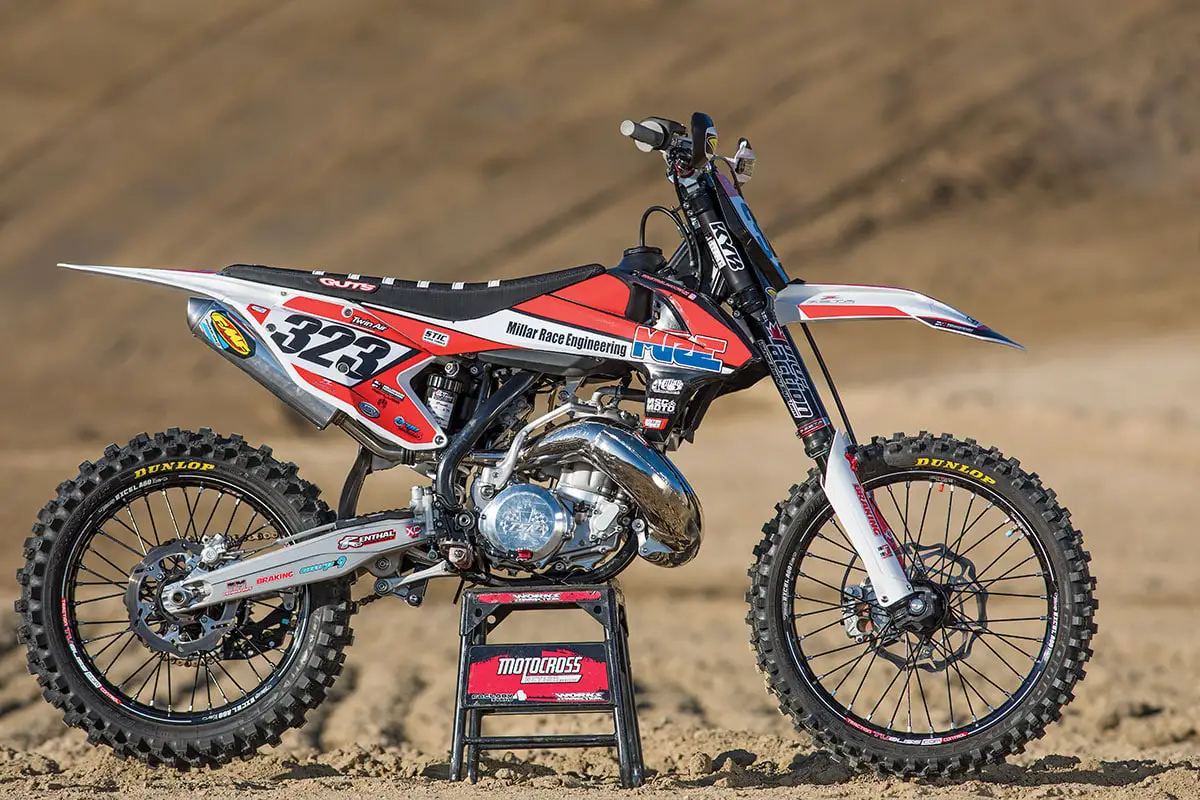
The Honda KTR500 was the creation of Adam Millar of Millar Racing Engineering (MRE). This was not Adam’s first rodeo, as he has shoehorned more than 30 Honda CR500 engines into donor chassis. The Honda CR500 remained basically the same from 1993 until it was discontinued after the 2001 model year. Over the years, as inventory of CR500 parts has been depleted, many CR500 components have been replicated or reincarnated in billet.

The CR500 cylinder used on the Honda KTR500 was from the 1989 through 2001 configuration. These production cylinders were made with a cast-iron liner. Adam Millar replaced this liner with an aluminum one that was fabricated by L.A. Sleeve, with Millennium Technologies applying a Nikasil bore finish.
TSR products built the engine cases for both our CR500 and KX500 project bikes out of 6061 billet (as well as the stator and clutch access covers for the CR500). These billet cases were designed with an updated clutch lifter system that eliminates the cable/lever actuator and mounts an integral hydraulic clutch slave cylinder for light and smooth action. The custom cases house the original third, fourth and fifth wide-ratio transmission gears. First gear is made lower, and fifth gear is taller than stock. This was done to achieve more evenly spaced gaps that are more predictable when riding.

Even though MRE built us a CR500 powerplant, his business is based on building and modifying both KX500 and CR500 engines. With the CR500 he built for us, he made internal modifications to the crankcases, cylinder and head. He used an OEM crankshaft that was in excellent condition and refurbished it himself. He added his signature decompression release in the head to make the big engine start easier. The crank was connected to a Wossner rod to actuate a standard bore Vertex piston. The ignition was a combination of OEM parts mixed with an aftermarket digital CDI that offered multiple map options and custom calibration.
The induction components were fabricated from scratch by Millar Racing Engineering. These parts joined a late-model 38mm Keihin PWK Air Striker carburetor to Moto Tassinari V-Force 2 components. The carb had an STIC Fuel carburetor metering block installed, which helped ensure a strong delivery at every throttle position.

To connect the power to the ground, the CR500 engine was fitted with a Rekluse Core manual clutch assembly. Adam told us that in his experience, most other clutch brands would slip as the high degree of torque over-rode their capabilities. To top the engine off, a standard FMF Honda CR500 pipe and Powercore 2 silencer were used. For this build, only the silencer mounting points had to be modified. This was a much simpler way to go than the KX500 exhaust.
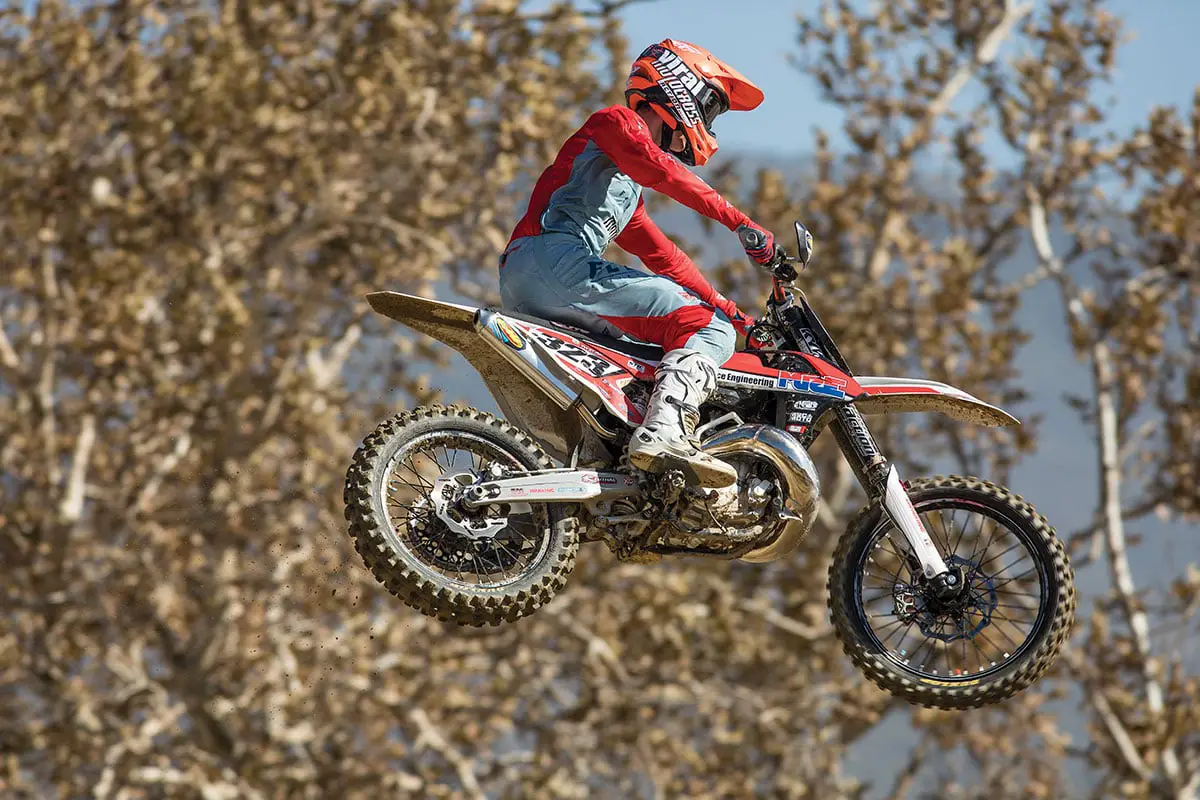
For the suspension, Adam kept the WP 4CS components and sent them to Pro Action Canada. They swapped out the horrible 4CS internals for Kayaba SSS internals. These internals were partnered with Zeta billet free pistons and fork caps. The fork tubes were anodized black and the legs DLC coated. The WP shock received a Pro Action reservoir and was valved to match the forks.
To minimize vibration, Adam called on some trick components. For the footpegs, polymer-damped XC Gear Spurz were used. These pegs isolate any metal-to-metal contact to reduce vibration. Plus, the polymers that the foot platform rides on compress upon impact to allow slight fore and aft flex. Adam also utilized XC Gear’s Mako 360 bar mounts, which are based off the same idea as their footpegs. Last on the list were Neken’s reduced-diameter SFH handlebars that allow for 4mm-thicker grips. This combination worked wonders.

Just as with the Kawasaki build, there are too many parts to list on the Honda KTR500. To start off, all fasteners, bolts, washers and axles are titanium (with a majority made by MRE). Faster USA laced up Excel A60 hoops with their own billet hubs, which were shod with the same Dunlop MX33s front and rear and TuBliss bead locking system as on the Kawasaki KX500. Braking brake pads and oversize rotors were used front and rear to help the pucker power. An MSC Moto Axis steering damper was mounted under the Neken bars. Guts Racing prepared a complete seat using a genuine KTM pan, its ribbed cover and denser foam. Cycra produced the bodywork, with Adam drafting the graphics on his iPhone. PistonBones printing handled the graphics. Of course, Twin Air helped out with the air supply.
WHAT WAS IT LIKE TO RIDE THE BIG CR500?
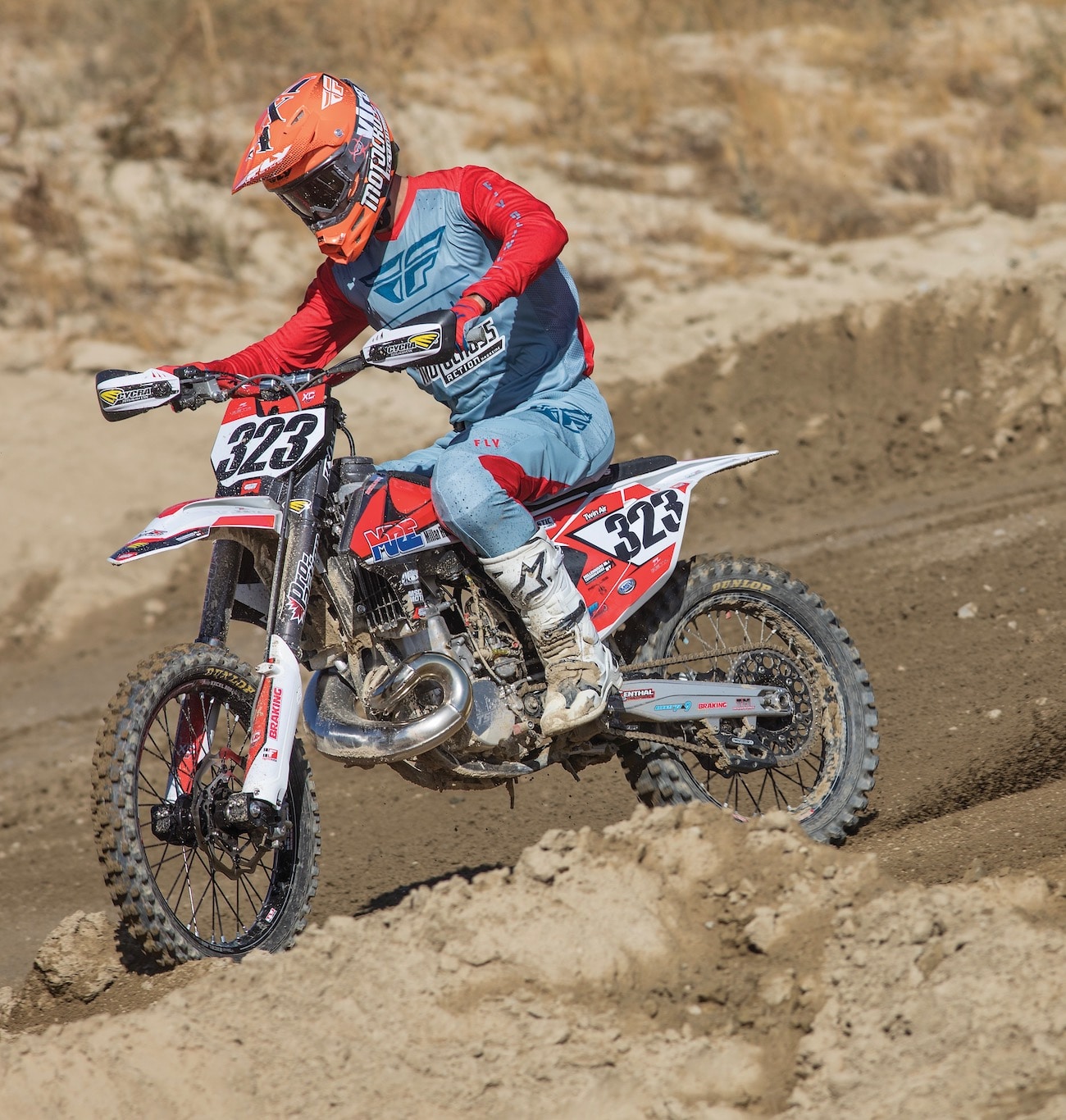
The MRE-built CR500 engine was completely different to ride from the KX500 engine. Even though many major components were the same, such as the chassis, it was Dr. Jekyll and Mr. Hyde, with the Honda KTR500 being the good doctor and the Kawasaki KTX500e being his dark inner self. The Honda CR500 was a tame version of the Kawasaki KX500 build. It didn’t lash out; it wasn’t scary when the throttle was at the stops. It was calm and collected. It didn’t tremor when the engine built its power; it simply sang rather than roared. It offered a low-to-mid style of power. MXA test riders could click up to third and just leave it there. It pulled out of corners with delight. It got power to the ground without the front wheel coming up.
The power was deceiving. It felt slow, but by the time you remembered you were on a 500cc two-stroke, you were going lightning fast. Every test rider loved this engine. It was more usable. Not more powerful, just more likely to put the power in the ground. Unlike with the Kawasaki KTX500e, there was no “wow” factor with the Honda KTR500.
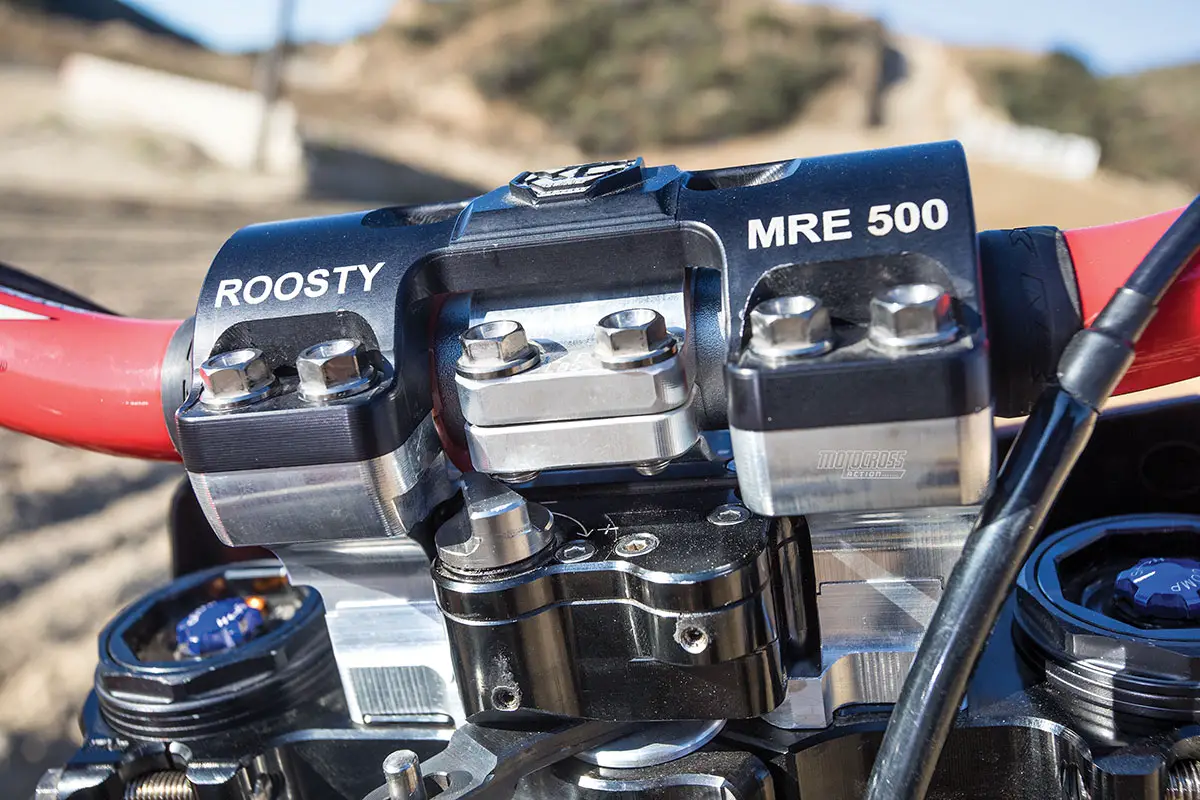
Handling was the strong suit on the CR500-powered KTM chassis. It handled as well or better than any production bike on the showroom floor. It turned on a dime, and its Pro Action suspension handled with precision. It absorbed everything in its path. It was on the soft side for our faster testers, and it bottomed out on occasion if we hit a big hole or landed hard. But, for the average guy, this chassis and suspension setup was a dream. Remember, both the Kawasaki and Honda share the same chassis, so the overall improvement in the Honda’s handling is primarily due to power delivery.

There were many good things that MXA test riders had to say about this bike, but the most talked about was its lack of vibration. There simply was none. How could that be? We never heard of such a thing with such a big smoker powerplant; however, that is where the genius of MRE came into play.

A bike that shifts with ease and has zero vibration—and a chassis that does everything exceptionally well and offers an easy-to-ride powerplant—was considered impossible with such an archaic engine design; however, MRE did it.
DR. JEKYLL VERSUS MR. HYDE
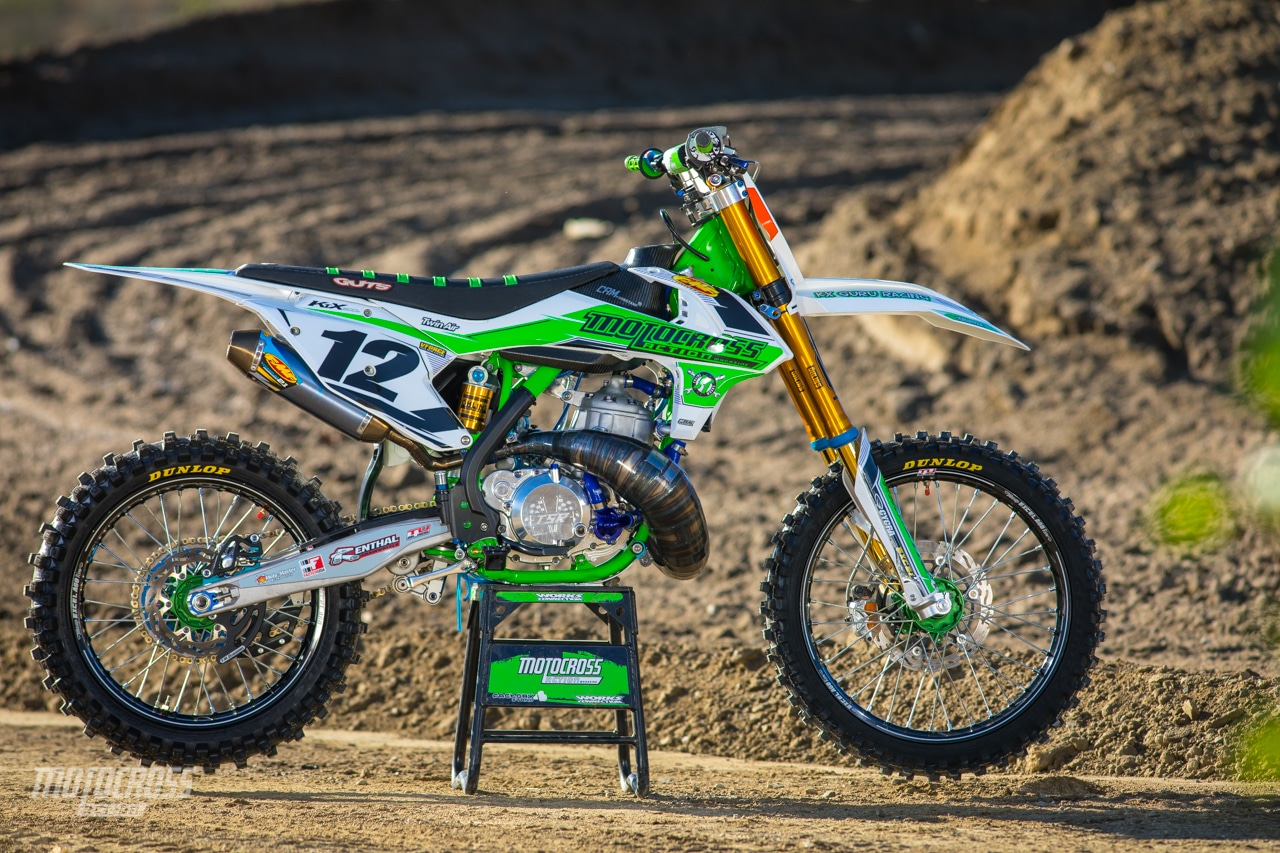
This isn’t a case of evil versus good—just two very different personalities with both having their pluses and minuses. To decipher which one is superior is just about impossible, unless we are basing the results on what one person would like more than another. But even that is hard.
No one looks forward to kick-starting a 500cc two-stroke engine in an electric-start world. Even though the KX500 engine gained significant weight from its electric starter, which was felt on the track, we still absolutely loved having the push-button starter, especially while we watched the other tester try to execute the perfect kick to turn over the CR500 powerplant.
No one builds an expensive 500cc two-stroke dirt bike to not have the most power possible. Half the thrill of building the bike is seeing the massive dyno numbers on paper. And, we have to say that the power of the Kawasaki KTX500e took our breath away. It was fast—scary fast. But, that’s part of the appeal of a 500ccc two-stroke.
The Honda KTR500 handled best for the average rider. We aren’t surprised—every serious motocross racer from the old days told us up front that “the KX500 had a better engine, but everyone hated the cumbersome chassis. The Honda CR500 powerband wasn’t as good, but the CR handled and felt better, which is why every MXA test rider chose to race the Honda over the Kawasaki KX500 back in the day.” Those sentiments still hold true. The Honda KTR500 was tuned with precision. The Pro Action-tuned suspension was plush and consistent, and the smooth style of power aided the superb handling.
On the other hand, the Kawasaki KTX500e seemed to suit our faster testers. The suspension held up better in the stroke. It was tailored for high-speed racing, whereas the Honda KTR500 was a bike that offered more comfort and confidence.
The CR500 engine was as smooth as they get. It was calm yet powerful, and you felt zero vibration in your hands. The KX500 engine roared with authority. It offered more power over a longer period of time than the CR500 engine. Although it was easy to manage the power, it did have a wicked side. It was eye-watering fast, and at times too much for mere mortals.
Both bikes had their own style and purpose, which is why it is impossible to choose a winner across the board. While the Kawasaki KTX500e is the power king, the KTR500 takes the handling crown. These bikes have the same bones yet two distinctly different personalities, which is why this is a true test between Dr. Jekyll and Mr. Hyde.
MXA FIRST RIDE VIDEO: MILLAR RACING CR500
MXA FIRST RIDE VIDEO: KX GURU RACING KX500 RACING KX500



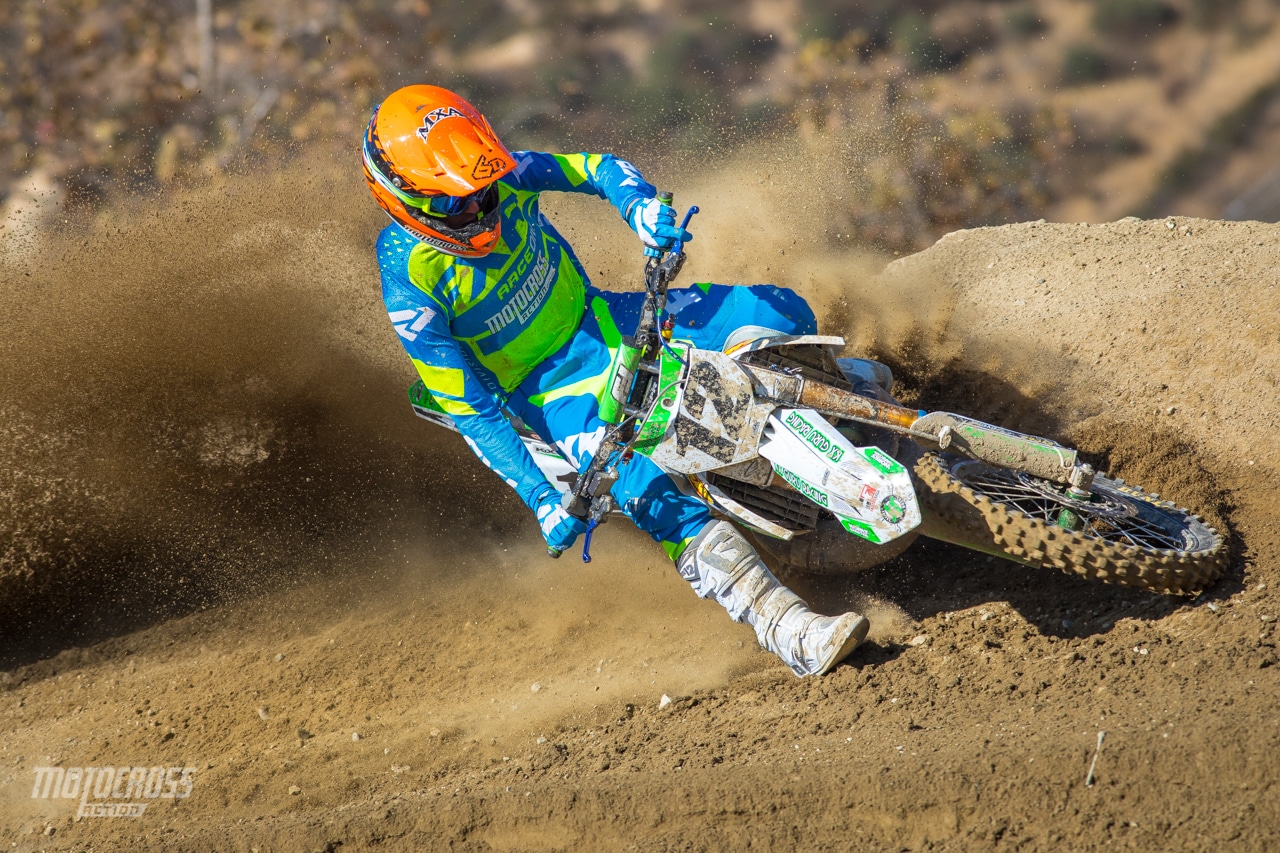


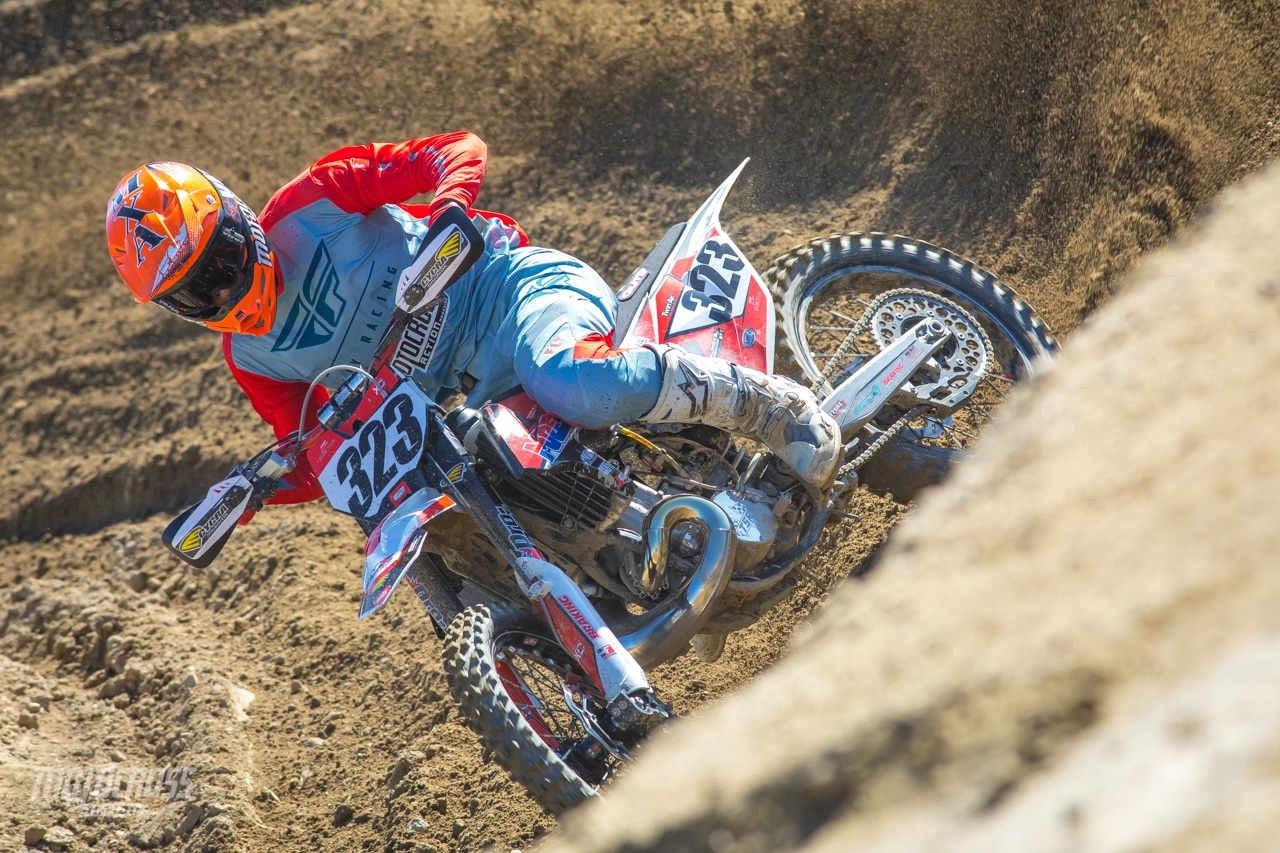


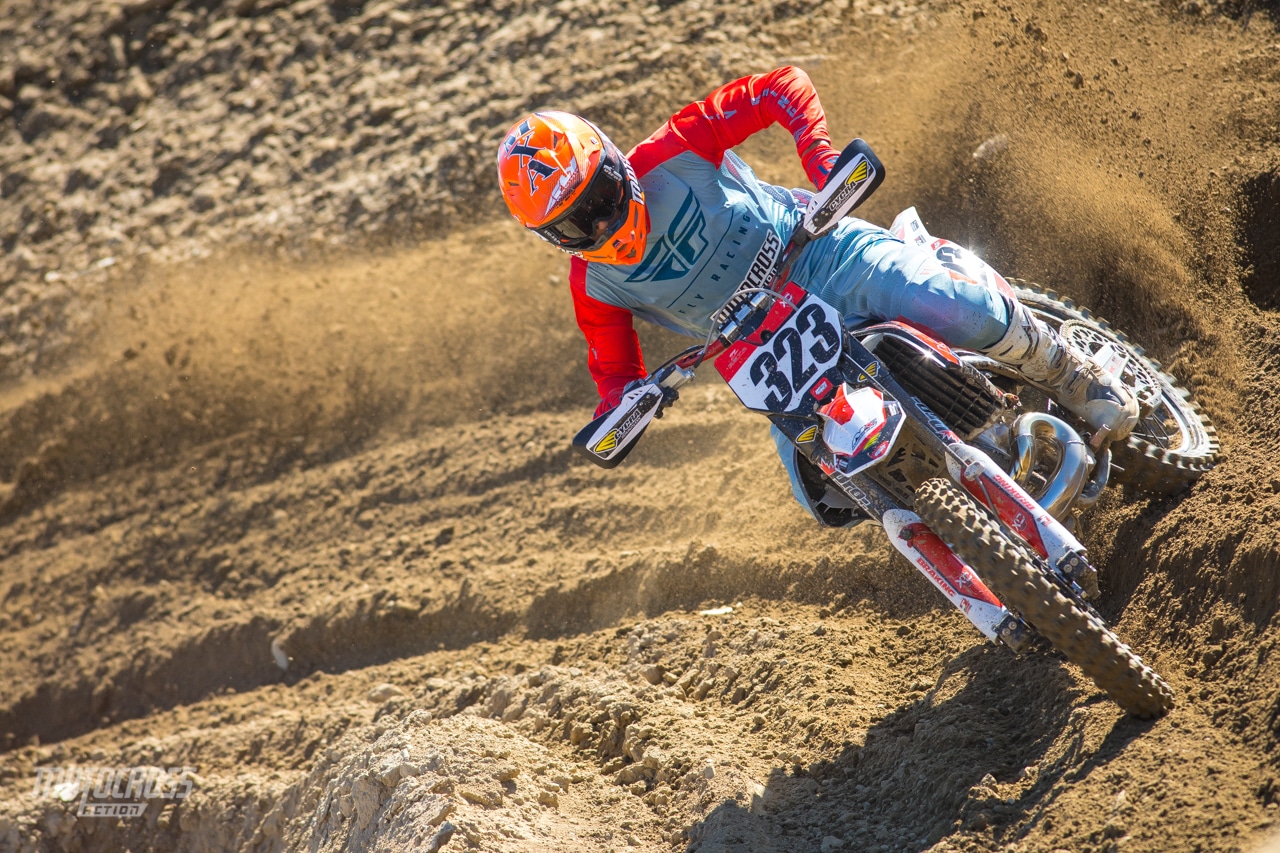



Comments are closed.